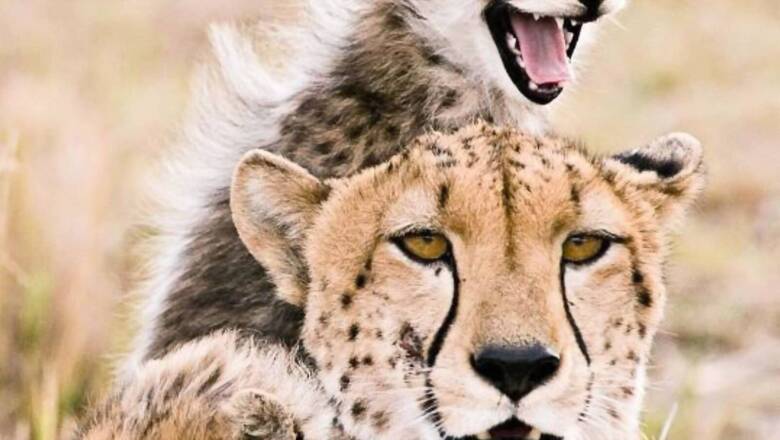Science-Wise: Why India Must Not Ignore Other Extant Species in Its Wild Pursuit of African Cheetahs

views
Incredibly light on its feet, the blazingly fast cheetah is perhaps the only large mammal that was hunted to extinction in India in the mid-century. Almost 70 years after the world’s fastest cat disappeared from its forests, the key wild predator re-entered the country’s forests yet again — but this time, travelling all the way from African Savannas to Central India — in one of the largest inter-continental animal translocations in recent years.
What perhaps make the project stand out is the scale at which it is being executed. Close to 50 cheetahs would be translocated from Namibia and South Africa over a period of five years as per the government’s Action Plan. The first batch of around eight cheetahs arrived on September 17. The founder stock will be provided a home in Madhya Pradesh’s Kuno Pavlpur National Park (KNP) spread over 748 sq. km.
The goal is to enable cheetah to establish its truly self-perpetuating population at Kuno, and then bring the rest of the animals at different stages. Considering the time required for the animal to establish its population, and the very nature of the animal to not easily adapt to new environments — there is indeed a lot at stake.
CHEETAH VS LION
The Asiatic cheetah that was wiped out from India in 1960s is now only found in Iran, and is categorised as critically endangered. Since, it is not possible to source the animal from Iran, India has brought another sub-specie of cheetah — the African Cheetah, which can provide it with substantial numbers of suitable cheetah for several years.
“Instead of spending crores in introducing African cheetahs all the way from another continent to India, why cannot we conserve our own native critically endangered species?” says wildlife biologist Ravi Chellam, who is currently the CEO of Bengaluru-based Metastring Foundation, and Coordinator of the Biodiversity Collaborative.
One such species is the Asiatic Lion – whose only surviving population roams in the now overcrowded forests of Gir and thousands of square kilometres of unprotected human-dominated habitats in Gujarat. The approximately 700 lions often referred to as India’s pride have been fighting diseases, disasters, poaching, encroachment and the pressure of living alongside a growing human population to recover from the brink of extinction.
MP’s Kuno National Park, where the African Cheetahs would now be introduced, is the same site which was identified for translocating a few Asiatic Lions from Gir in 1995 and subsequently ordered by the Supreme Court to be implemented within six months in 2013 – an issue that continues to challenge Indian wildlife conservationists. The two big cats are known to co-exist, but there are apprehensions that bringing Cheetahs would further push back the translocation of Asiatic lions from Gujarat.
“Having all the Asiatic Lions as one population at a single site makes it very vulnerable. It is very important that we use data and science to guide our conservation priorities.
Translocation of lions is yet to start despite being listed as a priority in the National Wildlife Action Plan 2017-2031 and the Supreme Court Order of 2013. It is extremely critical that at least one other wild population of lions is established at Kuno to mitigate risks and enhance its long-term conservation status,” says Chellam, who has been involved with research and conservation of the Asiatic Lions since 1985.
DISSAPEPARING GRASSLANDS
According to the environment ministry, besides conserving the big cat, Project Cheetah in itself will be a boon to the ecosystem. Cheetahs live in open plains; their habitat is predominantly where their prey lives — grasslands, scrubs and open forest systems, semi-arid environments and temperatures that tend to be hotter compared to cooler regimes. So, in saving cheetahs, one would have to save not only its prey-base comprising certain threatened species, but also other endangered species of the grasslands and open forest ecosystems, some of which are on the brink of extinction.
The plan perhaps is expected to reap long-term dividends, but it is easier said than done. The imminent challenge here is India’s fast disappearing grasslands, which are being destroyed routinely for commercial projects, and extant species which are fighting for survival. Cheetah thrive in the grasslands and open forests, and, if India has to establish a long self-perpetuating population of the animal, it will have to first prioritise management of its neglected grasslands, and not the other way around.
“We are losing our grasslands and they are shrinking across states. One can only hope that Project Cheetah helps bring attention to this much neglected part of our ecosystem. Translocation of cheetah is not a one-off exercise; the animal will need enough space for its future expansion as well. The priority here is to conserve these grasslands, work with pastoralists. And, we can begin by first doing away with the term ‘wastelands’ to prevent their further degradation,” says conservation biologist Neha Sinha from Bombay Natural History Society (BNHS).
CONSERVATION PRIORITIES
As the first batch of this keystone specie lands in India after completing quarantine in Namibia, the onus will be on the country to provide a safe habitat to the animal. Africa’s Savannas are different from the grasslands of India, and it usually rains much more than it does in Africa – there are challenges that the fastest animal on earth will have to endure before its future generations make India a natural habitat.
Till then, it is important that the grandeur of the entire project does not sway us away from what it has originally set out to achieve – conserving and protecting the wildlife that is racing to extinction, lest it ends up as an exercise in futility. There are species of birds and animals like the Great Indian Bustard or the caracal who are on the brink of extinction due to loss of habitat, pressure on land and other man-made challenges that need immediate attention, and the current project must help India achieve the collective goal.
Read all the Latest News India and Breaking News here



















Comments
0 comment